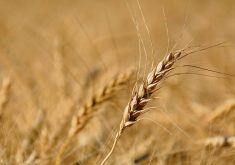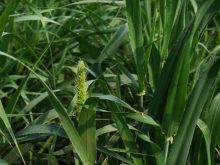Wheat, durum and barley growers have a new pre-harvest herbicide option now that BASF has received Codex maximum residue limits (MRLs) for its product Heat LQ.
While “there were probably some wheat acres already harvested,” according to Dan Packer, BASF’s cereals crop manager, this agreement will provide an additional pre-harvest option for farmers who still have wheat, barley or durum out in the field.
Heat LQ has been specifically listed on 2017-18 producer declaration cards as a product that can’t be applied for pre-harvest use on wheat, durum, barley and flax.
Read Also

India slaps 30 per cent import duty on yellow peas
India has imposed a 30 per cent duty on yellow pea imports with a bill of lading date on or after Nov. 1, 2025.
Grain buyers are aware of the new MRLs, said Wade Sobkowich, executive director of the Western Grain Elevator Association. “Grain companies will be disregarding that portion of the declaration.”
Each of the elevators “is taking a different approach,” Packer said. Some grain companies will send out new declaration forms; others will handle the issue verbally.
With no MRLs set for flax or mustard, however, Heat LQ should not be used on those crops this harvest season.
Codex standards are food standards used by the World Trade Organization as basic trading guidelines. MRLs establish a safe maximum level of residue from a particular product.
Having no established MRL doesn’t necessarily mean the product is unsafe. However, without an agreed-upon maximum limit, an importer may reject shipments containing any residual traces of the product.
Cereals Canada welcomed the change for Heat LQ. “This will now allow Canadian (cereals) farmers to have access to this technology,” president Cam Dahl told the Manitoba Co-operator in an email.
Other products still on the WGEA’s prohibited list include chlormequat on wheat or any other cereal; quinclorac on canola; metconazole on canola; fluoxastrobin on soybeans; and benzovindiflupyr on soybeans.
Heat LQ, a Group 14 saflufenacil herbicide, “has both contact and systemic properties,” Packer said. This gives it the ability to move through plants and dry down broadleaf weeds. It can also be used as a pre-seed, pre-emergent and chemfallow herbicide.
Packer said it’s very effective on hard-to-control weeds such as volunteer Roundup Ready canola, wild buckwheat and redroot pigweed. He recommended tank mixing Heat LQ with glyphosate for complete control.
Heat LQ should be used with high water volume — a minimum of 10 gallons per acre — and applied at the standard label rate of 40 acres per case.
Heat LQ is also recommended for use in canola, chickpeas, dry common beans, field peas, red lentils, soybeans and sunflowers.
— Leeann Minogue is the editor of Grainews at Griffin, Sask. Includes files from Allan Dawson of the Manitoba Co-operator at Miami, Man.












